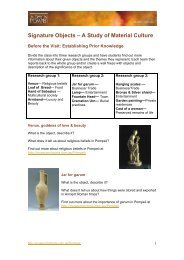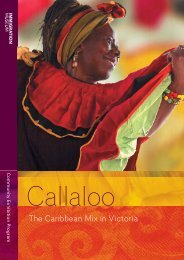Exhibition notes for A Day in Pompeii - Museum Victoria
Exhibition notes for A Day in Pompeii - Museum Victoria
Exhibition notes for A Day in Pompeii - Museum Victoria
Create successful ePaper yourself
Turn your PDF publications into a flip-book with our unique Google optimized e-Paper software.
http://museumvictoria.com.au/<strong>Pompeii</strong><br />
<strong>Exhibition</strong> Notes<br />
of favourite gladiators. These gladiators were often <strong>for</strong>eign slaves, and both men and<br />
women idolised them; one graffito reads: "Celadus the Thracian makes all the girls sigh."<br />
Theatrical per<strong>for</strong>mances were another, gentler <strong>for</strong>m of popular enterta<strong>in</strong>ment. <strong>Pompeii</strong>’s<br />
theatre was an old one, built <strong>in</strong> the second century BC <strong>in</strong> the Greek style and then<br />
enlarged and modernised <strong>in</strong> the Augustan period to make it more like a Roman theatre.<br />
Comedies and rustic farces were per<strong>for</strong>med there, as well as mimed re-enactments of<br />
mythological scenes. The dramas of ancient Greece must also have been popular,<br />
judg<strong>in</strong>g from the wall pa<strong>in</strong>t<strong>in</strong>gs depict<strong>in</strong>g the famous Greek playwright Menander. A<br />
small roofed odeum, or concert hall, was built next to the theatre <strong>in</strong> about 75 BC to<br />
provide an additional venue <strong>for</strong> musical enterta<strong>in</strong>ment.<br />
FASHION<br />
High fashion and heavenly adornment, Roman-style<br />
<strong>Pompeii</strong> was a hub of trade and travel, and its wealthier residents were knowledgeable<br />
about all the latest fashion and beauty trends from Rome and beyond. The standard<br />
garment <strong>for</strong> women throughout the Roman Empire was the stola, a long pleated dress<br />
that was draped around the body and p<strong>in</strong>ned together with brooches (fibulae). The style<br />
of this garment was traditional and didn’t vary much, which made make-up and<br />
hairstyl<strong>in</strong>g even more important as a way to express a woman’s beauty and <strong>in</strong>dividuality.<br />
The Roman beauty ideal was a white face, bright red lips and very dark eyes. To<br />
achieve this look, women used foundation creams and face powder made from white<br />
lead or powdered chalk and animal fat. Lipstick was made from ochre or molluscs, and<br />
eyel<strong>in</strong>er from soot or antimony powder. Fashionable women washed <strong>in</strong> water perfumed<br />
with c<strong>in</strong>namon and balsam, and often used ass’s milk on the sk<strong>in</strong> to prevent wr<strong>in</strong>kles.<br />
Other oil-based scents were derived from spices and herbs like cardamom, saffron,<br />
lavender, rose and orange, and were stored <strong>in</strong> small, tightly-stoppered glass bottles.<br />
Mirrors made from highly polished bronze or silver were, of course, essential items <strong>in</strong> the<br />
wealthy woman’s beauty kit.<br />
The blond hair of Celtic women (usually slaves) was particularly prized <strong>for</strong> mak<strong>in</strong>g wigs,<br />
but when this was not available, many women dyed their hair blonde and used hairnets<br />
of f<strong>in</strong>e gold thread and hairp<strong>in</strong>s of bone to hold their often elaborate hairstyles <strong>in</strong> place.<br />
Fashions <strong>in</strong> hairdress<strong>in</strong>g changed rapidly, much as they do today. In <strong>Pompeii</strong>’s early<br />
years, women favoured simple chignons or buns at the back of the head, or plaits tied<br />
back <strong>in</strong> a band, but <strong>in</strong> the last years of <strong>Pompeii</strong> built-up hairstyles became popular.<br />
These were very complex and often required several slaves work<strong>in</strong>g at the same time,<br />
manipulat<strong>in</strong>g hairpieces and false curls to produce a tower<strong>in</strong>g head of hair.<br />
Both men and women wore r<strong>in</strong>gs <strong>for</strong> adornment, which could be made from pla<strong>in</strong> gold,<br />
bronze, copper or silver. More elaborate jewellery featured pearls or gemstones such as<br />
cornelian, lapis lazuli or onyx, and the most detailed pieces featured delicately carved<br />
cameo or <strong>in</strong>taglio stones. Hoop earr<strong>in</strong>gs and gold bracelets with a coil<strong>in</strong>g snake design<br />
were especially popular.<br />
6


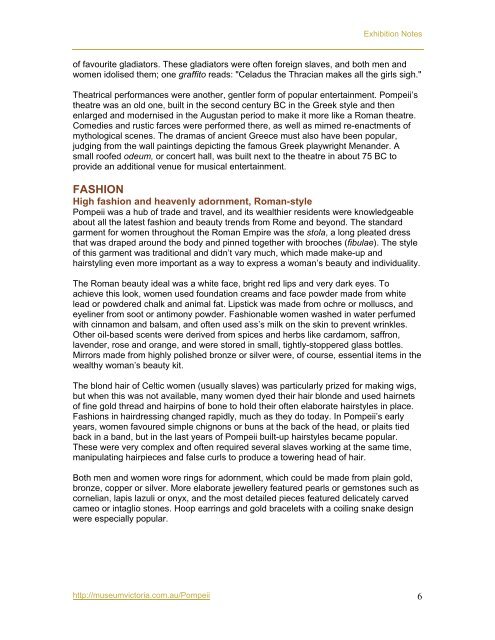



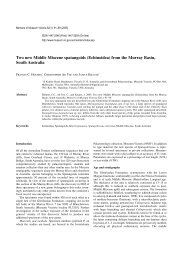
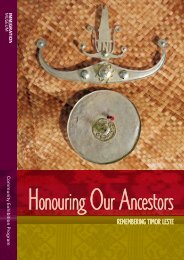
![[PDF] Andiamo a Pompei- Teacher Notes ... la - Museum Victoria](https://img.yumpu.com/16309810/1/190x245/pdf-andiamo-a-pompei-teacher-notes-la-museum-victoria.jpg?quality=85)


